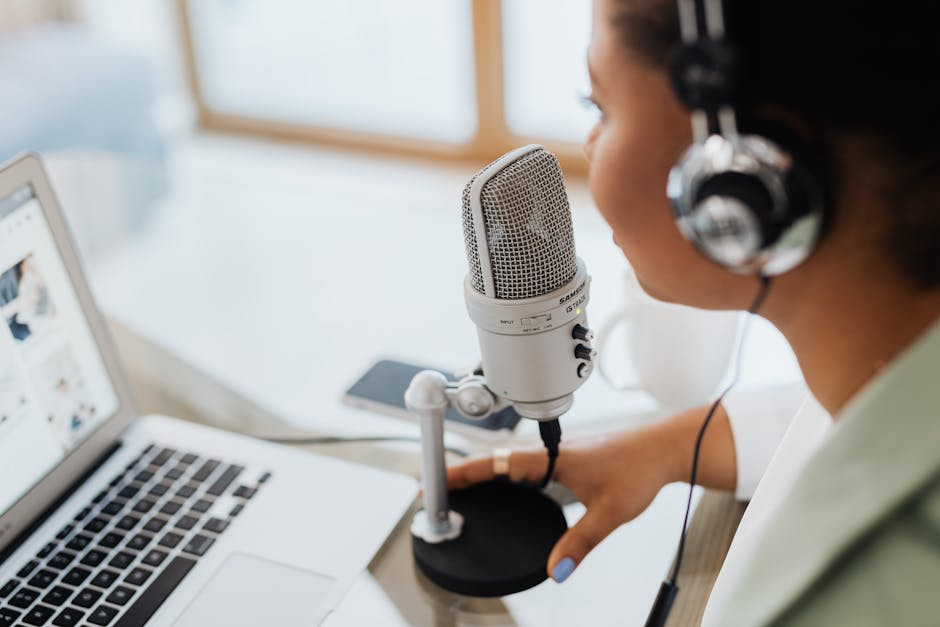The Silent Symphony: Unveiling AI Soundscapes for Workspace Bliss
Imagine working in an environment so perfectly tailored to your needs that it fuels your creativity, boosts your focus, and melts away distractions—all through the power of sound. Welcome to the world of AI-generated soundscapes, a revolutionary concept seeking to transform remote workspaces into harmonious havens of productivity. In this article, we will explore how this innovative technology works, its practical applications, and how these soundscapes can significantly enhance your work experience.
The Need for Sound in Remote Work Environments

In the era of remote work, many individuals find themselves struggling with distractions at home. From the constant hum of family activity to the incessant notifications from digital devices, creating an optimal working environment is often easier said than done. Research has shown that sound plays a critical role in enhancing mood and productivity. According to a study by the Harvard Business Review, the right auditory environment can enhance concentration and overall workplace satisfaction.
However, finding the right sounds can be complicated; not everyone finds silence conducive, nor do they thrive in over-stimulating environments. This is where AI-generated soundscapes step in to bridge the gap between distraction and tranquility.
What Are AI-Generated Soundscapes?

AI-generated soundscapes use algorithms to create unique audio environments tailored to specific moods or tasks. Driven by machine learning models, these soundscapes can combine various auditory elements—like nature sounds, ambient music, or urban noises—to produce a seamless auditory experience that resonates with the listener's needs.
Imagine working while listening to the gentle rustle of leaves or the soft trickling of a stream, all perfectly blended to help you focus. Soundscapes can be customized to provide that serene backdrop that transports you anywhere from a tranquil forest to the bustle of a cozy café.
How AI Creates Tailored Sound Experiences

The technology behind AI-generated soundscapes leverages large datasets of environmental sounds and musical compositions. AI algorithms analyze these datasets to identify patterns, allowing them to compose new pieces that evoke specific effects. Features such as amplitude, frequency, and timbre—including layering multiple sounds—combine to evoke various emotional responses.
For instance, if you’re seeking to spark creativity, a soundscape composed of light piano melodies, sporadic bird calls, and a subtle breeze might be engineered just for you. The adaptability of AI allows it to learn from user feedback, refining soundscapes to suit individual preferences over time.
The Benefits of Using AI Soundscapes in Your Workspace

-
Enhanced Focus and Productivity: Background sounds can mask distracting noise, helping you stay on task. According to Mindful, gentle soundscapes can optimize cognitive performance, making them a useful tool when tackling complex projects.
-
Mood Regulation: AI-generated soundscapes can be easily adjusted to better suit your emotional state throughout the workday. Feeling anxious? Switch to a serene soundscape that mimics a tranquil beach. Getting tired? Transition to upbeat tempo to awaken your senses and renewal.
-
Flexibility for Individual Preferences: Given that sound is subjective, these AI soundscapes cater to personal tastes, ensuring that employees can select a sound environment that resonates with them, thereby individualizing and improving the remote workflow experience.
-
Reduced Fatigue: Listening to well-crafted soundscapes can mitigate some of the mental fatigue associated with prolonged work tasks. Sounds act as a gentle stimulant, invigorating cognitive function without overwhelming the senses.
Consuming Soundscapes: Platforms and Applications

Several tools and applications today provide access to AI-generated soundscapes. Platforms like Endel and myNoise allow users to explore a variety of sounds curated specifically for different activities, whether studying, reading, or relaxing.
Endel: Utilizing AI-generated soundscapes, Endel adjusts sound compositions based on real-time data such as weather, time of day, and even your heart rate, creating a dynamic auditory experience.
myNoise: This platform offers a wide selection of sound generators based on different environments—ranging from rainfall to busy cafés—allowing you to customize the mixture according to your preference and needs.
These platforms illustrate the robust connection between artificial intelligence and auditory creativity, establishing a new norm in how we relate to sound and productivity.
Crafting Your Own AI Soundscape

While many platforms offer pre-generated soundscapes, the fun doesn’t have to stop there. DIY methods can lead you to create a personalized auditory environment tailored specifically to your preferences.
-
Select Your Environment: Think about the ambiance you wish to replicate. Do you want a calming forest, a rainy day, or perhaps a lively street corner?
-
Choose Fidelity: Utilize free sound libraries available online. Websites like Freesound offer thousands of sound clips that can be blended together in audio editing software to create your unique soundscape.
-
Edit and Layer: Use production tools such as GarageBand or Audacity to overlay various sounds. Experiment with volume levels to ensure balance among the auditory elements.
-
Finalize and Test: Save your soundscape and trial it during periods of focus. Observe how it affects your concentration and mood. Feel free to adjust elements that don’t resonate and refine the experience.
The Scientific Basis of Sound and Mood Enhancement

Studies reveal that sound frequency can influence human emotions and physiological responses. For instance, lower frequencies can calm the nervous system, while higher frequencies might stimulate cognitive functions.
A pivotal research paper by Nature Neuroscience indicates that certain sound patterns can impact emotional regulation and cognitive tasks, underscoring the relationship between sound and performance in remote work.
Soundscapes: Changing the Future of Remote Workspaces

As remote work continues trending, the thought of employing AI-generated soundscapes can revolutionize our approach to working environments. Prioritizing auditory comfort not only enhances well-being but also embraces a new form of environmental design, one that considers moods and productivity.
Corporate entities can also explore this aspect; tools that utilize AI-generated soundscapes could play a role in office design strategies, helping employees thrive in various settings.
Real-World Applications: Leading the Way

Organizations have already begun experimenting with AI-generated soundscapes in their workspaces. Companies like Airbnb and Volkswagen are utilizing soundscapes to create immersive experiences for their employees, fostering an enhanced work atmosphere that encourages creativity, collaboration, and well-being.
Creating a workplace that allows for AI-adapted auditory environments could enhance employee satisfaction, reduce turnover, and increase output quality.
Future Innovations in Sound Design

As technology continues to evolve, the potential for AI-generated soundscapes expands, paving the way for more sophisticated applications. The blend of Virtual Reality (VR) and augmented soundscapes could lead to immersive experiences where sound, visuals, and even physical sensations converge to create complete environments tailored to the worker's needs.
Imagine a future where you can don a VR headset that transports you to a serene mountain view, accompanied by dynamic soundscapes that adapt to your mood. This level of innovation could redefine our concept of the workspace entirely.
Implementing AI Soundscapes in Your Daily Routine

To begin integrating AI soundscapes into your routine, set small goals. Commit to a week of experimentation—test different environments during your work sessions. Reflect on how these soundscapes influence your productivity and emotional state. Feedback loops can refine your auditory experiences, making adjustments as you delve deeper into your preferences.
Building On Your Digital Well-being
Embracing AI-generated soundscapes is part of a larger trend towards optimizing our interaction with technology to prioritize well-being, focus, and creativity. Coupled with digital tools and gadgets, this creates a holistic approach that prioritizes individual preferences, ultimately benefiting mental health.
For more insights on how technology intersects with well-being, explore articles such as Unmasking Deepfakes: Protect Your Online Identity or Gamifying Productivity: Transform Your Workflow Through Play.
Final Thoughts
AI-generated soundscapes present an exciting opportunity not only to enhance productivity but also to create a dynamic balance between work and well-being. By implementing these soundscapes into your remote work routine, you are taking a step towards a more harmonious and productive experience.
The future of workplace environments, especially in a remote setting, will likely hinge on personalized auditory landscapes that resonate with our individual needs and preferences. Why not be part of this evolving narrative? Begin your exploration and immerse yourself in the silent symphony that awaits.



